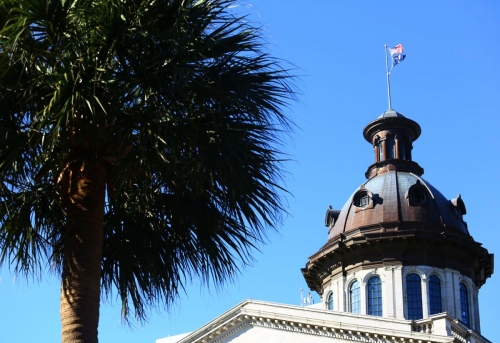NATIONAL REVIEW: South Carolina Quietly Fixing Its Tax Problems. A blue state or two could learn from our example.
Because South Carolina wisely resisted total lockdown during Covid, coming out of the pandemic, we were in a good position. But on fiscal issues, state leaders had been content to kick the can down the road for far too long. Would they ever get around to addressing festering tax policy problems?
Fortunately, this story has a happy ending.
It was right before Covid that I was in the office of Governor Henry McMaster. The discussion turned to South Carolina’s individual income-tax rate, the highest in the southeast. McMaster had heard wonks opine that the “effective rate” (the average of what citizens were actually paying across all taxpayers) was lower than the stated rate, but he didn’t buy it. “All I know is when we try to recruit businesses to this state, all they see is a big ole seven,” he said.
McMaster was referring to the Tax Foundation graphic that shows each state’s top individual income-tax rate. It was indeed a “big ole seven,” as in 7 percent . South Carolina’s rate was the highest in the southeast by far. Not only that, the highest tax rate kicked in at $14,400 per year.
The horrendous 7 percent rate was not a new theme for McMaster. He had been calling for a cut in the state income tax since he ran for governor the first time in 2010, a race eventually won by Nikki Haley.
It was during the Haley administration that Palmetto Promise Institute was born. PPI was formed by state business and elected leaders who saw the need for a state public policy “idea machine” that would propose innovative solutions from a free-market perspective. One of our first initiatives was a call for comprehensive tax reform. Our battle cry? “South Carolina’s Tax Code — unfair, unstable, uncompetitive.”
In 2016, Governor Haley took up the cause, calling for a swap that would have reduced the income tax from 7 percent to 5 percent over ten years, while raising the state fuel tax by ten cents per gallon over three years. Despite Haley’s endorsement, that effort failed.
After McMaster became governor in 2017, he made a call for slicing the income-tax rate a regular part of his bully pulpit, pounding away at that 7 percent in his annual State of the State speeches.
In 2022, the General Assembly finally heard his pleas, and ours. For the first time since its inception in 1959, South Carolina’s top marginal individual income-tax rate was reduced. The implementation schedule proposed by the Haley administration was truncated from ten to five years. The initial cut would be from 7 percent to 6.5 percent, the brackets would be flattened, and they would be indexed for inflation to prevent bracket creep. The 6.5 percent rate was set on a course to decline to 6 percent by 2027.
But the pressure was on. Our neighboring states (and competitors in economic development) kept cutting. North Carolina, already at 4.5 percent, adopted a plan to cut its rate a bit each year until it reached 3.99 percent by 2027.
So McMaster sounded the alarm again in his January address, when he stated: “I ask the General Assembly to speed up the income-tax-cut schedule, and let taxpayers keep even more of their own money.”





